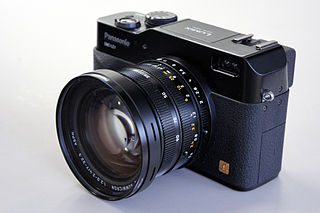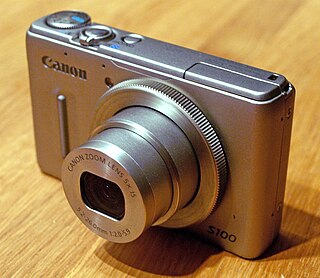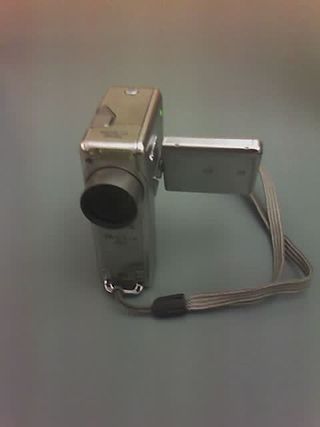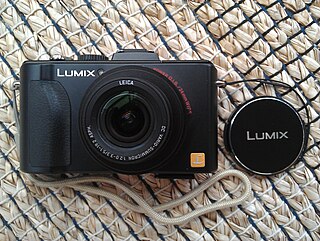
A digital camera is a camera that captures photographs in digital memory. Most cameras produced today are digital, largely replacing those that capture images on photographic film. Digital cameras are now widely incorporated into mobile devices like smartphones with the same or more capabilities and features of dedicated cameras. High-end, high-definition dedicated cameras are still commonly used by professionals and those who desire to take higher-quality photographs.

The Digital IXUS is a series of digital cameras released by Canon. It is a line of ultracompact cameras, originally based on the design of Canon's IXUS/IXY/ELPH line of APS cameras.

A digital single-lens reflex camera is a digital camera that combines the optics and the mechanisms of a single-lens reflex camera with a solid-state image sensor and digitally records the images from the sensor.

The Canon PowerShot G is a series of digital cameras introduced by Canon in its PowerShot line in 2000. The G series cameras are Canon's flagship compact models aimed at photography enthusiasts desiring more flexibility than a point-and-shoot without the bulk of a digital single-lens reflex camera.

The PowerShot Pro1 is a digital camera made by Canon, announced in February 2004 and was discontinued first quarter of 2006. It uses a Sony-built 2/3 in (17 mm) 8.3 megapixel CCD image sensor, which gives a usable image size of approximately 8.0 megapixels. It was the most expensive fixed-lens camera sold by Canon at the time, and thus the top of the PowerShot range. It was the first fixed lens designated a Canon L series lens, a designation normally reserved for expensive EF-series SLR lenses.

Lumix is Panasonic's brand of digital cameras, ranging from pocket point-and-shoot models to digital SLRs.

Bridge cameras are cameras that fill the niche between relatively simple point-and-shoot cameras and interchangeable-lens cameras such as mirrorless cameras and single-lens reflex cameras (SLRs). They are often comparable in size and weight to the smallest digital SLRs (DSLR), but lack interchangeable lenses, and almost all digital bridge cameras lack an optical viewfinder system. The phrase "bridge camera" has been in use at least since the 1980s, and continues to be used with digital cameras. The term was originally used to refer to film cameras which "bridged the gap" between point-and-shoot cameras and SLRs.
The Canon PowerShot S is a series of digital cameras released by Canon, as part of the wider PowerShot range. The S-series was originally a line of compact point-and-shoot cameras, slowly evolving into a prosumer line of cameras slotting right beneath the G-series cameras. The line later branched off into Canon's line of super-zoom cameras. The PowerShot ELPH line is a branch of the S-series, due to its model number designations in the United States, as well as the similarities between the PowerShot ELPH S100 and the PowerShot S10

The Canon EOS-1D is a professional digital single-lens reflex camera launched in November 2001 as part of Canon's flagship EOS-1 series. It was the first digital camera in the EOS-1 line, succeeding Canon's final flagship film camera, the 1V. It was also the first professional-level digital camera developed and released entirely by Canon, the previous D2000 being a collaborative effort with Kodak. It has a 1.3x crop factor with a CCD image sensor sourced from Panasonic. The camera shares its body design with the Canon EOS-1V 35mm camera. It was complemented by the slower, higher-resolution 1Ds in 2002 and succeeded by the 1D Mark II in April 2004.

The Canon PowerShot S100 is a high-end 12.1-megapixel compact digital camera announced and released in 2011. It was designed as the successor to the Canon PowerShot S95 in the S series of the Canon PowerShot line of cameras.

Live preview is a feature that allows a digital camera's display screen to be used as a viewfinder. This provides a means of previewing framing and other exposure before taking the photograph. In most such cameras, the preview is generated by means of continuously and directly projecting the image formed by the lens onto the main image sensor. This in turn feeds the electronic screen with the live preview image. The electronic screen can be either a liquid crystal display (LCD) or an electronic viewfinder (EVF).

The Canon PowerShot S200 is a high-end 10.1-megapixel compact digital camera announced and released in 2014 by Canon. The PowerShot S200 is a cheaper version of the Powershot S110, utilizing a 10.1 MP CCD instead of a 12 MP CMOS sensor. It is built as a smaller brother the S-series of the Canon PowerShot line of cameras. The S200 does not have RAW image file formatting.
General Imaging was a manufacturer of digital cameras headquartered in Torrance, California, established in 2006 by Hiroshi "Hugh" Komiya, a former executive of Olympus Corporation. General Imaging sold their cameras internationally under the General Electric name, used under license. General Imaging was licensed to manufacture and sell their cameras under the AgfaPhoto name in Japan. On October 5, 2015, General Imaging filed for bankruptcy.

The Canon PowerShot TX1 is a Canon digital camera. It was released on February 22, 2007 The TX1 is a hybrid device designed for both still imagery and video recording. It offers both HDTV movie capture, as well as 10× stabilized zoom and 7.1 megapixel sensor. It is designed to improve upon hybrid offerings by competitors such as the Sony Cyber-shot M1, Sony Cyber-shot M2, and Pentax MX4. It is oriented vertically and uses the camcorder-like swivel LCD viewing screen. Canon compares the hybrid camera's size to that of the Canon ELPH series of cameras. The company distinguishes the camera for its optical image stabilizer technology, DIGIC III image processor, face detection technology and red-eye effect correction with a mention of its built-in lens cover and scratch-resistant, anti-reflective LCD screen.

The Kodak Digital Camera System is a series of digital single-lens reflex cameras and digital camera backs that were released by Kodak in the 1990s and 2000s, and discontinued in 2005. They are all based on existing 35mm film SLRs from Nikon, Canon and Sigma. The range includes the original Kodak DCS, the first commercially available digital SLR.

The Fujifilm FinePix products are a line of digital cameras produced by Fujifilm. They include compact point and shoot models, tough, waterproof models, bridge digital cameras, digital SLRs and mirrorless cameras. Many use Fujifilm's proprietary Super CCD technology sensors and CMOS sensors for high-end models.

The Canon PowerShot S95 is a high-end 10.0-megapixel compact digital camera announced and released in 2010. It was designed as the successor to the Canon PowerShot S90 in the S series of the Canon PowerShot line of cameras.

The Panasonic Lumix DMC-LX5, or LX5, is a high-end compact "point and shoot" camera launched by Panasonic in 2010 to succeed the LX3.



















